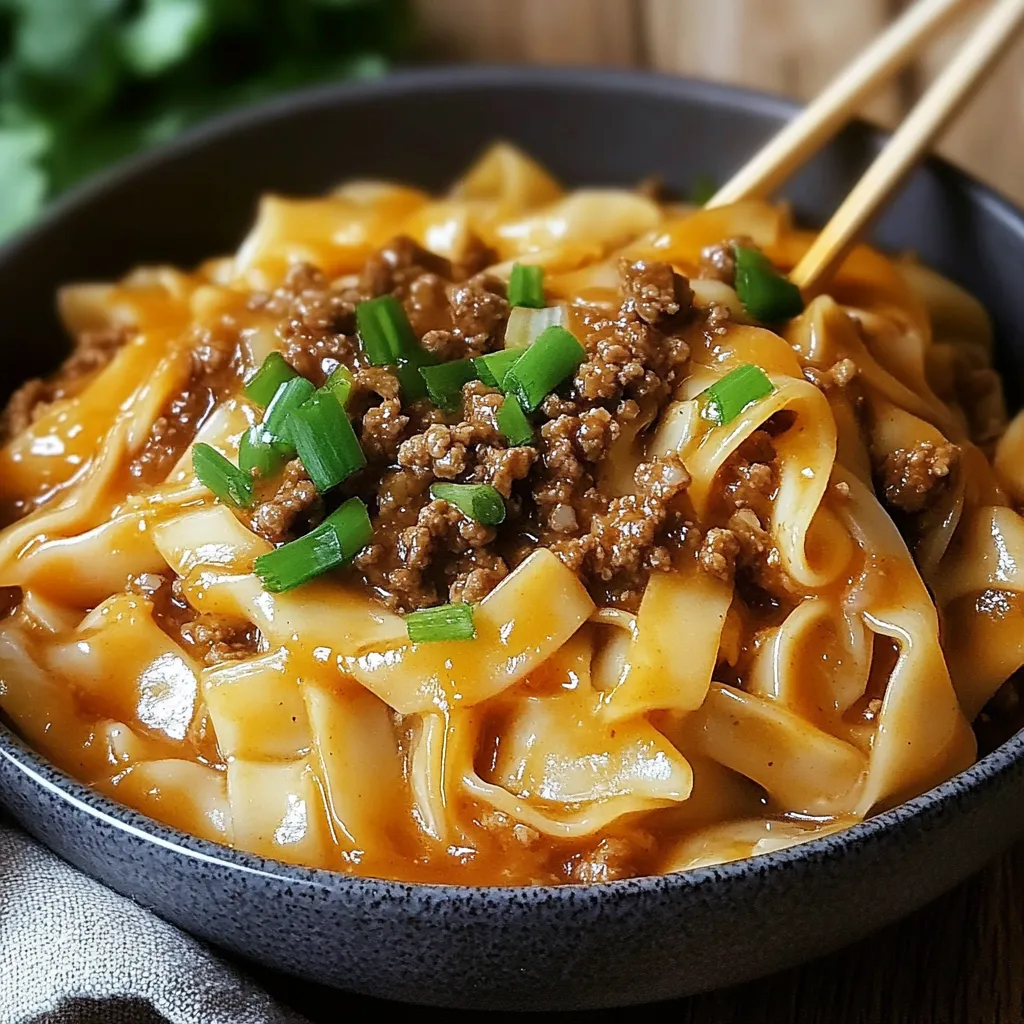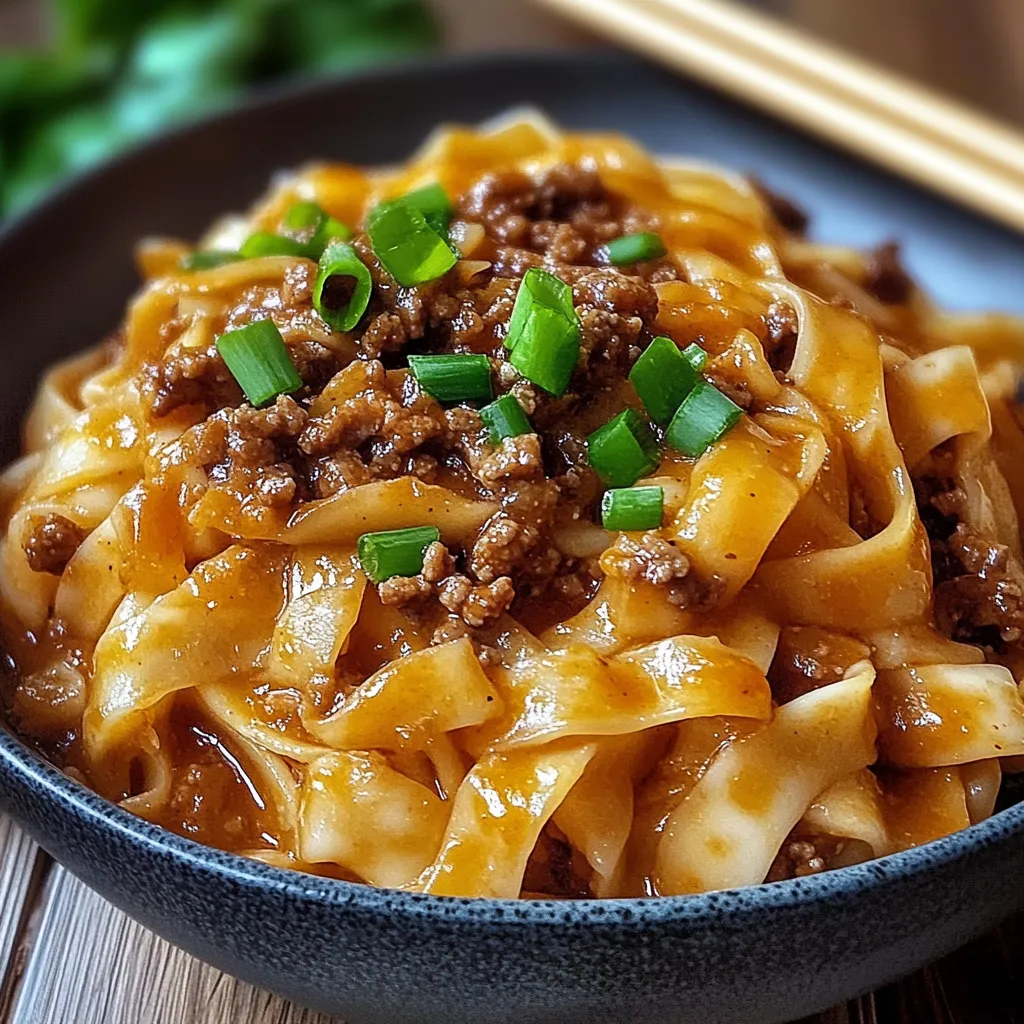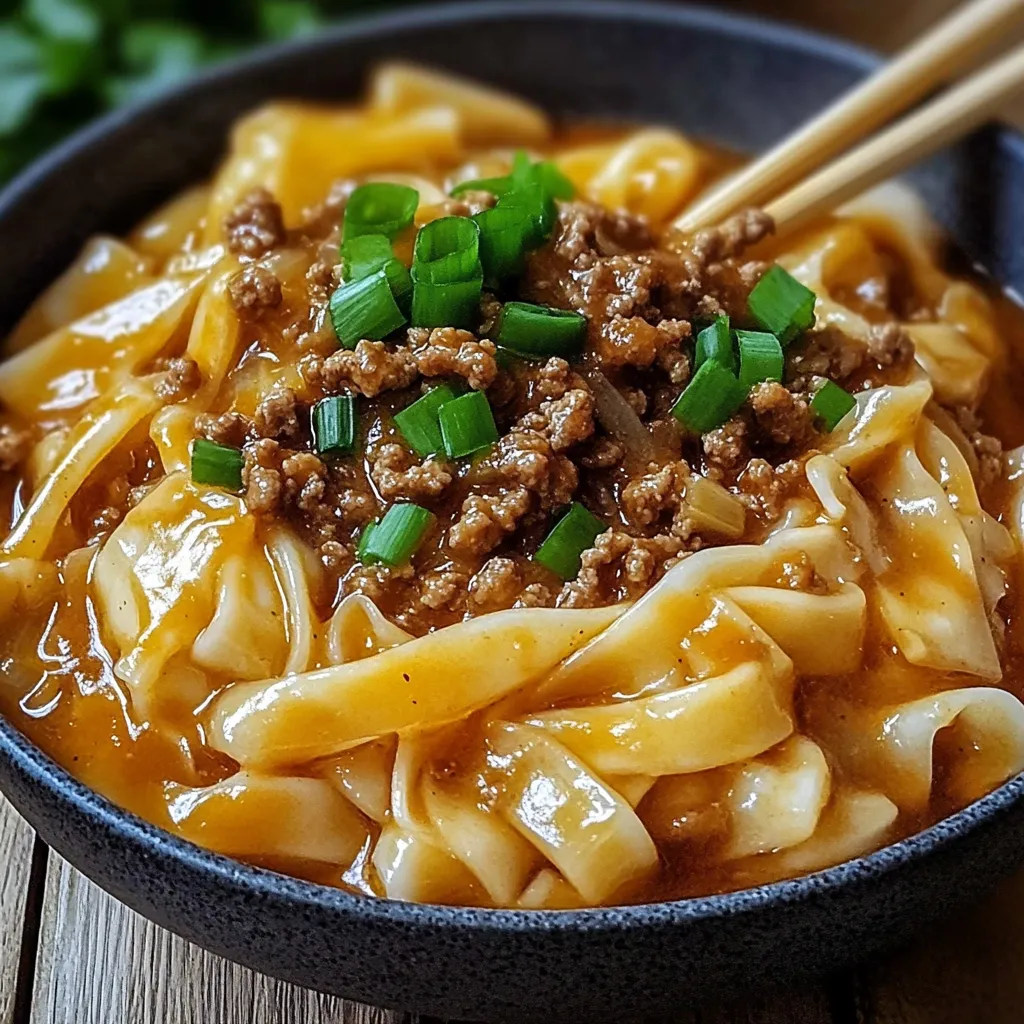 Pin it
Pin it
Savory ground beef and tender noodles come together in a rich, sweet-savory sauce that delivers restaurant-quality flavor in less than 30 minutes. This Mongolian Ground Beef Noodles recipe transforms humble ingredients into an irresistible weeknight meal that satisfies those takeout cravings without the wait or expense. The glossy sauce, with its perfect balance of soy, hoisin, and brown sugar, coats every strand of pasta and morsel of beef for a dish that's both comforting and exciting.
I created this recipe on a night when I was craving Mongolian beef but didn't have steak in the house. Using ground beef was initially just a practical substitution, but my family actually preferred this version for its saucy texture that clings to the noodles. Now it's in our regular rotation, especially on busy weeknights when we need something quick but don't want to sacrifice flavor.
Essential Ingredients
- Ground Beef: Lean ground beef provides meaty flavor without excessive fat—80/20 offers the best balance of flavor and texture
- Linguine: These flat, long noodles hold the sauce beautifully—traditional Asian noodles can be substituted if you have them
- Brown Sugar: Creates the signature Mongolian sweetness that balances the savory elements—dark brown sugar adds extra depth
- Soy Sauce: Provides essential umami foundation—low-sodium versions work well if you're watching salt intake
- Hoisin Sauce: This sweet-savory condiment adds complexity and body to the sauce—find it in the Asian section of most grocery stores
- Fresh Garlic: Minced garlic adds aromatic depth that dried simply can't match—the more the better for garlic lovers
- Green Onions: These add a fresh, mild onion flavor and bright color as a finishing touch—use both white and green parts
Cooking Method
- Cook The Noodles:
- Begin by bringing a large pot of salted water to a rolling boil. Add 10 ounces of linguine or your preferred noodles and cook according to package directions until al dente, usually 8-10 minutes. The noodles should retain a slight firmness as they'll continue cooking briefly when combined with the sauce. Drain well but don't rinse—the starchy exterior helps the sauce adhere better.
- Brown The Beef:
- While the pasta cooks, heat a large skillet over medium-high heat. Add one pound of ground beef, breaking it into small pieces with a wooden spoon. Cook until no pink remains, about 5-7 minutes. If there's excessive fat, drain most of it, leaving just a tablespoon or so for flavor. The beef should be browned but not crispy for the best texture.
- Create Aromatic Base:
- Reduce the heat to medium and add five cloves of minced garlic to the cooked beef. Sauté for about 30-60 seconds until fragrant but not browned. Garlic burns quickly and becomes bitter, so watch it carefully. This brief cooking releases the essential oils while maintaining its vibrant flavor.
- Build The Sauce:
- To the skillet, add one-third cup brown sugar, one-third cup soy sauce, three tablespoons hoisin sauce, one-quarter cup beef broth, half teaspoon ground ginger, half teaspoon black pepper, and a pinch of red pepper flakes if you enjoy some heat. Stir to combine, allowing the sugar to dissolve completely. Bring to a gentle simmer for about 2 minutes to begin melding the flavors.
- Thicken To Perfection:
- In a small bowl, whisk together one tablespoon cornstarch with two tablespoons water until completely smooth with no lumps. Pour this slurry into the simmering sauce while stirring constantly. Continue to cook for 1-2 minutes until the sauce thickens to a glossy consistency that coats the back of a spoon. The cornstarch needs to reach a certain temperature to activate fully, so be patient.
- Combine And Finish:
- Add the drained pasta directly to the skillet with the beef and sauce. Using tongs, gently toss everything together until the noodles are completely coated with the rich sauce. Allow it to cook for another 1-2 minutes so the pasta can absorb some of the sauce and flavors. Garnish with sliced green onions just before serving for a fresh contrast to the rich dish.
 Pin it
Pin it
My teenage son, who typically picks at his dinner, cleaned his plate and immediately asked if there was more. What surprised me most was watching him devour the green onions that he normally pushes aside. Something about how they complement the sweet-savory sauce made even the "green stuff" appealing to him.
Perfect Pairings
Complete your meal with sides that complement these rich, flavorful noodles. Steamed broccoli or bok choy provides a fresh, green element that balances the savory dish while adding nutritional value. A simple cucumber salad with rice vinegar dressing offers cooling crunch that contrasts beautifully with the warm, saucy noodles. For a more substantial spread, include some vegetable spring rolls or dumplings on the side for an Asian-inspired feast that still comes together quickly.
Creative Variations
Customize this versatile recipe to suit your tastes and what you have on hand. Create a spicier version by adding sliced fresh chilis or doubling the red pepper flakes for heat that builds with each bite. Make a vegetable-packed meal by adding thinly sliced bell peppers, snow peas, or carrots when sautéing the garlic. For a lower-carb option, substitute the linguine with zucchini noodles or shirataki noodles—adjust the final cooking time to avoid overcooking these alternatives.
Smart Storage
Maintain flavor and texture with proper storage techniques. Refrigerate leftovers in airtight containers for up to three days—the flavors often deepen overnight, making day-two noodles even more delicious. When reheating, add a splash of water or beef broth to loosen the sauce, as the noodles will have absorbed liquid while storing. Warm over medium-low heat on the stovetop for best results, or microwave in 30-second intervals, stirring between each until heated through. For meal prep, prepare the beef and sauce separately from the noodles, combining them only when ready to serve.
I've made countless noodle dishes over the years, but this Mongolian beef version has become my reliable go-to when I need something delicious without much fuss. What makes it special is how it transforms basic ingredients into something that tastes like it came from a restaurant. The sauce has that perfect balance of sweet and savory that keeps you coming back for one more bite. Even on nights when I'm tempted to order takeout, I remind myself that this dish is ready in less time than delivery would take—and honestly tastes better too.
 Pin it
Pin it
Frequently Asked Questions
- → Can I substitute the ground beef with something else?
- Yes! This recipe works great with ground chicken, turkey, or pork. For a vegetarian version, you could use crumbled tofu or a plant-based ground meat substitute. Just adjust cooking times accordingly as these alternatives may cook faster than beef.
- → How can I make this gluten-free?
- To make this dish gluten-free, use rice noodles or your favorite gluten-free pasta instead of linguine. Also be sure to use gluten-free soy sauce (tamari) and check that your hoisin sauce is gluten-free, as many brands contain wheat.
- → Is Mongolian beef actually from Mongolia?
- Despite its name, Mongolian beef is not traditional Mongolian cuisine. It's an Americanized dish created in Chinese-American restaurants, known for its sweet and savory flavors, which are quite different from authentic Mongolian cooking styles.
- → Can I make this less sweet?
- Absolutely. The brown sugar gives Mongolian beef its signature sweetness, but you can reduce it to 2-3 tablespoons instead of 1/3 cup for a less sweet version. You might also want to reduce the hoisin sauce slightly as it contains sugar too.
- → What vegetables would work well with this dish?
- Great additions include thinly sliced bell peppers, broccoli florets, snow peas, or sliced mushrooms. Add them after browning the beef and sauté for a few minutes before adding the sauce ingredients for a complete one-pan meal.
- → Can I make this ahead of time?
- Yes, this dish reheats well. You can prepare it completely and store it in the refrigerator for up to 3 days. When reheating, add a splash of water or beef broth as the noodles tend to absorb the sauce over time. Microwave or gently reheat on the stovetop.
